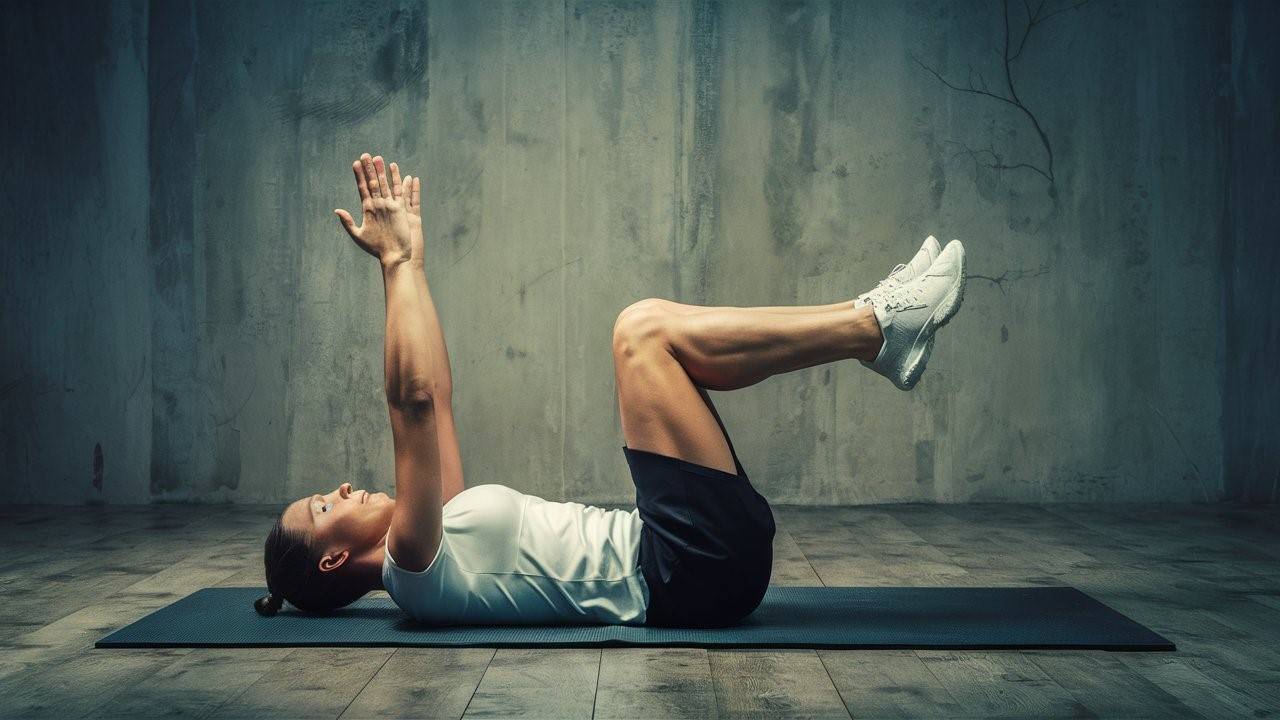Master your core with the dead bug exercise. Learn proper form, variations, and benefits for a stronger, more balanced body. Unlock your fitness potential today!
Quick Guide:

The dead bug exercise is a powerful core-strengthening move that:
- Targets the deep abdominal muscles
- Improves spine stability
- Enhances overall balance
- Can be done anywhere with no equipment
For best results:
- Perform 3 sets of 10-15 reps per side
- Focus on maintaining a neutral spine
- Breathe steadily throughout the movement
NOTE: This quick guide provides immediate value to busy readers while encouraging them to read further for more detailed information.]
What is the Dead Bug Exercise?
The dead bug exercise is a fundamental core-strengthening movement that mimics the position of a dead bug on its back. Don’t let the quirky name fool you – this exercise is a powerhouse for developing core stability, improving posture, and enhancing overall athletic performance.
Dead bug exercise targets multiple muscle groups simultaneously, including:
- Rectus abdominis (six-pack muscles)
- Transverse abdominis (deep core muscles)
- Obliques (side abdominal muscles)
- Lower back muscles
- Hip flexors
NOTE: This section provides a clear definition and highlights the primary muscles worked, setting the foundation for the rest of the post.
The Benefits of Dead Bug Exercise
Incorporating the dead bug exercise into your fitness routine can lead to numerous benefits:
- Improved Core Stability: By engaging the deep abdominal muscles, the dead bug exercise enhances your core’s ability to stabilize your spine during everyday movements and athletic activities.
- Better Posture: Strengthening the core and lower back muscles helps maintain proper alignment, reducing the risk of back pain and improving overall posture.
- Enhanced Balance: The contralateral movement pattern (opposing arm and leg) in the dead bug exercise improves coordination and balance.
- Reduced Risk of Injury: A strong core acts as a protective shield for your spine, lowering the risk of back injuries.
- Increased Athletic Performance: The stability gained from dead bug exercise translates to improved performance in various sports and physical activities.
NOTE: Highlighting the benefits encourages readers to try the exercise and demonstrates its value for various fitness goals.
How to Perform the Dead Bug Exercise Correctly

Proper form is crucial for maximizing the benefits of dead bug exercise and avoiding potential injuries. Follow these steps:
- Starting Position:
- Lie on your back on a mat
- Raise your arms straight up towards the ceiling
- Lift your legs, bending your knees at a 90-degree angle
- Engage your core by pressing your lower back into the mat
- The Movement:
- Lower your right arm behind your head while simultaneously extending your left leg
- Keep your lower back pressed against the mat throughout the movement
- Pause briefly at the bottom of the movement
- Return to the starting position
- Repeat on the opposite side (left arm, right leg)
- Breathing:
- Inhale as you lower your arm and leg
- Exhale as you return to the starting position
- Repetitions and Sets:
- Begin with 3 sets of 10 repetitions per side
- As you build strength, increase to 15-20 repetitions per side
NOTE: Providing clear, step-by-step instructions with accompanying images helps readers visualize and perform the exercise correctly.
Common Mistakes to Avoid in Dead Bug Exercise
To ensure you’re getting the most out of your dead bug exercise, watch out for these common errors:
- Arching the Lower Back:
- Mistake: Allowing your lower back to lift off the mat
- Solution: Focus on keeping your lower back pressed against the mat throughout the movement
- Moving Too Quickly:
- Mistake: Rushing through the movement
- Solution: Perform the exercise slowly and with control, focusing on muscle engagement
- Neglecting Breath Control:
- Mistake: Holding your breath or breathing irregularly
- Solution: Maintain a steady breathing pattern throughout the exercise
- Lifting the Head and Neck:
- Mistake: Straining to watch your movements
- Solution: Keep your head and neck relaxed on the mat, looking up towards the ceiling
- Inconsistent Arm and Leg Extensions:
- Mistake: Varying the height of arm and leg extensions between repetitions
- Solution: Aim for consistent, controlled movements at the same height each time
NOTE: Addressing common mistakes helps readers troubleshoot their form and avoid potential injuries.
Dead Bug Exercise Variations for All Fitness Levels
The dead bug exercise can be modified to suit various fitness levels and goals. Here are some variations to try:
- Beginner: Heel Taps
- Keep your arms at your sides
- Alternately lower each heel to tap the ground
- Maintain core engagement throughout
- Intermediate: Single-Limb Dead Bug
- Extend one arm or one leg at a time
- Keep the other limbs in the starting position
- Advanced: Weighted Dead Bug
- Hold a light dumbbell or medicine ball in your hands
- Perform the standard movement with added resistance
- Expert: Stability Ball Dead Bug
- Place a stability ball between your lower back and the wall
- Perform the standard movement while maintaining pressure on the ball
- Isometric Hold Dead Bug
- Lower the opposite arm and leg
- Hold the extended position for 10-30 seconds before switching sides
NOTE: Providing variations caters to a wider audience and allows for progression, keeping the exercise challenging and engaging
Incorporating Dead Bug Exercise in Your Workout Routine
To maximize the benefits of the dead bug exercise, consider these tips for including it in your fitness regimen:
- Warm-up: Use the dead bug exercise as part of your warm-up routine to activate your core before more intense exercises.
- Core Circuit: Include the dead bug exercise in a core-focused circuit along with planks, Russian twists, and bicycle crunches.
- Cool-down: Perform the dead bug exercise during your cool-down to reinforce proper core engagement and spinal alignment.
- Frequency: Aim to include the dead bug exercise in your routine 2-3 times per week for optimal results.
- Progression: Start with the basic movement and gradually incorporate more challenging variations as your strength improves.
NOTE: This section helps readers integrate the exercise into their existing routines, increasing the likelihood of consistent practice.
FAQs About the Dead Bug Exercise
Q: What does the dead bug exercise work on?
A: The dead bug exercise primarily targets the core muscles, including the rectus abdominis, transverse abdominis, obliques, and lower back muscles. It also engages the hip flexors and improves overall body coordination.
Q: Are dead bugs better than sit-ups?
A: Dead bug exercises are considered safer and more effective than traditional sit-ups. They put less strain on the neck and lower back while engaging more of the deep core muscles. Dead bugs also promote better spinal alignment and functional core strength.
Q: How many dead bugs should I make a day?
A: Start with 3 sets of 10-15 repetitions per side, performed 2-3 times a week. As you build strength, you can increase to 20 repetitions per side or incorporate more challenging variations. Listen to your body and adjust the volume based on your fitness level and goals.
Q: What are the mistakes for the dead bug exercise?
A: Common mistakes include arching the lower back, moving too quickly, neglecting proper breathing, lifting the head and neck off the mat, and inconsistent arm and leg extensions. Focus on maintaining a neutral spine, crawling and controlled, breathing steadily, and keeping movements consistent with optimal results.
Conclusion
The dead bug exercise is a versatile, effective core-strengthening movement that can benefit individuals of all fitness levels. By mastering this exercise and incorporating it regularly into your routine, you’ll develop a stronger, more stable core, improve your posture, and enhance your overall physical performance.
Remember to focus on proper form, breathe steadily, and progress gradually to reap the full benefits of the dead bug exercise. Your journey to a stronger core and better balance starts here!
Thank you for reading this comprehensive guide to the dead bug exercise. We hope you found it informative and actionable.
Recommended Reading



